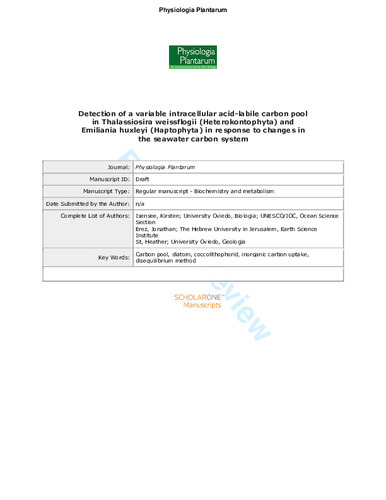Detection of a variable intracellular acid-labile carbon pool in Thalassiosira weissflogii (Heterokontophyta) and Emiliania huxleyi (Haptophyta) in response to changes in the seawater carbon system
Autor(es) y otros:
Palabra(s) clave:
Carbon pool
diatom
coccolithophorid
inorganic carbon uptake
desequilibrium method
Fecha de publicación:
Versión del editor:
Citación:
Resumen:
Accumulation of an intracellular pool of carbon (Ci pool) is one strategy by which marine algae overcome the low abundance of dissolved CO2 (CO2(aq)) in modern seawater. Toidentify the environmental conditions under which algae accumulate an acid-labile Ci pool, we applied a 14C pulse-chase method, used originally in dinoflagellates, to two new classes of algae, coccolithophorids and diatoms. This method measures the carbon accumulation inside the cells without altering the medium carbon chemistry or culture cell density. We found that the diatom Thalassiosira weissflogii ((Grunow) G.Fryxell & Hasle) and a calcifying strain of the coccolithophorid Emiliania huxleyi ((Lohmann) W.W.Hay & H.P.Mohler) develop significant acid-labile Ci pools. Ci pools are measureable in cells cultured in media with 2 to 30Emol L-1 CO2(aq) , in these cultures corresponding to a medium pH of 8.6 -7.9. The absolute Ci pool was greater for the larger-celled diatoms. For both algal classes the Ci pool became a negligible contributor to photosynthesis once CO2(aq) exceeded EmolL-1. Combining the 14C pulse-chase method and 14C disequilibrium method enabled us to assess whether E. huxleyi and T. weissflogii exhibited thresholds for foregoing accumulation of DIC or reduced the reliance on bicarbonate uptake with increasing CO2(aq). We showed that the Ci pool decreases with higher CO2:HCO3 - uptake rates.
Accumulation of an intracellular pool of carbon (Ci pool) is one strategy by which marine algae overcome the low abundance of dissolved CO2 (CO2(aq)) in modern seawater. Toidentify the environmental conditions under which algae accumulate an acid-labile Ci pool, we applied a 14C pulse-chase method, used originally in dinoflagellates, to two new classes of algae, coccolithophorids and diatoms. This method measures the carbon accumulation inside the cells without altering the medium carbon chemistry or culture cell density. We found that the diatom Thalassiosira weissflogii ((Grunow) G.Fryxell & Hasle) and a calcifying strain of the coccolithophorid Emiliania huxleyi ((Lohmann) W.W.Hay & H.P.Mohler) develop significant acid-labile Ci pools. Ci pools are measureable in cells cultured in media with 2 to 30Emol L-1 CO2(aq) , in these cultures corresponding to a medium pH of 8.6 -7.9. The absolute Ci pool was greater for the larger-celled diatoms. For both algal classes the Ci pool became a negligible contributor to photosynthesis once CO2(aq) exceeded EmolL-1. Combining the 14C pulse-chase method and 14C disequilibrium method enabled us to assess whether E. huxleyi and T. weissflogii exhibited thresholds for foregoing accumulation of DIC or reduced the reliance on bicarbonate uptake with increasing CO2(aq). We showed that the Ci pool decreases with higher CO2:HCO3 - uptake rates.
DOI:
Patrocinado por:
The work was funded by the European Union under ERC240222-PACE
Colecciones
- Artículos [37548]
- Geología [551]
- Investigaciones y Documentos OpenAIRE [8420]
Ficheros en el ítem




